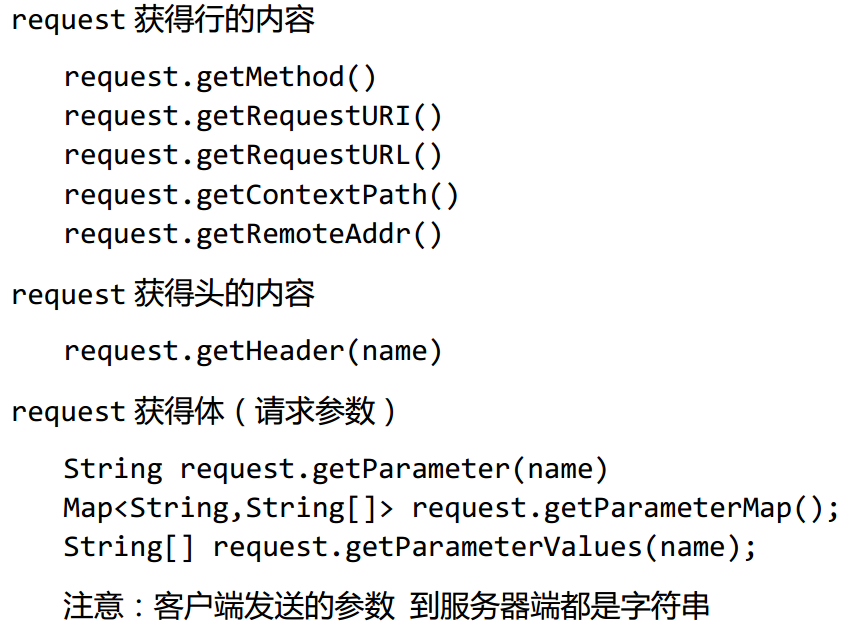1 Request 的简介和运行环境
1.HttpServletRequest 概述
我们在创建 Servlet 时会覆盖 service()方法,或 doGet()/doPost(),这些
方法都有两个参数,一个为代表请求的 request 和代表响应 response。
service 方法中的 request 的类型是 ServletRequest,而 doGet/doPost 方
法 的 request 的 类 型 是 HttpServletRequest , HttpServletRequest 是
ServletRequest 的 子 接 口 , 功 能 和 方 法 更 加 强 大 , 今 天 我 们 学 习
HttpServletRequest。
2.request 的运行流程
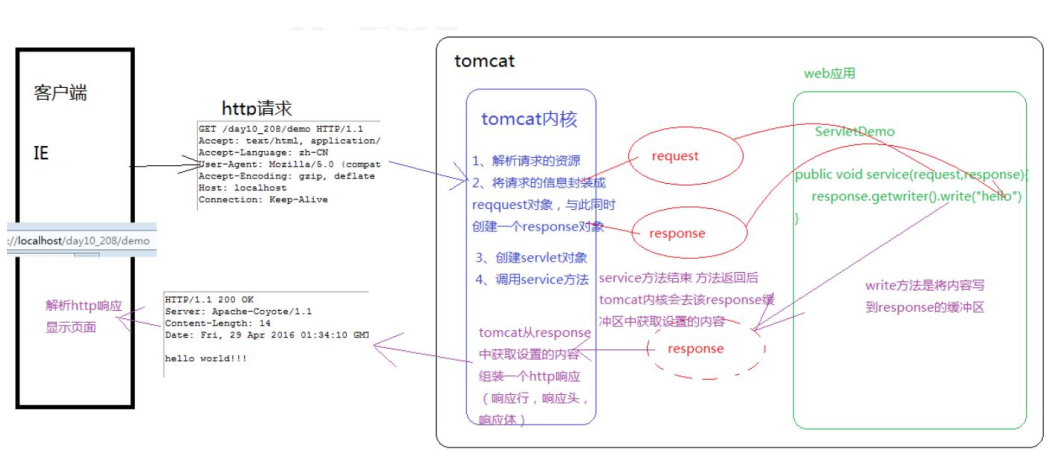
2 通过 request 获得【请求行】
1 通过抓包工具抓取 Http 请求
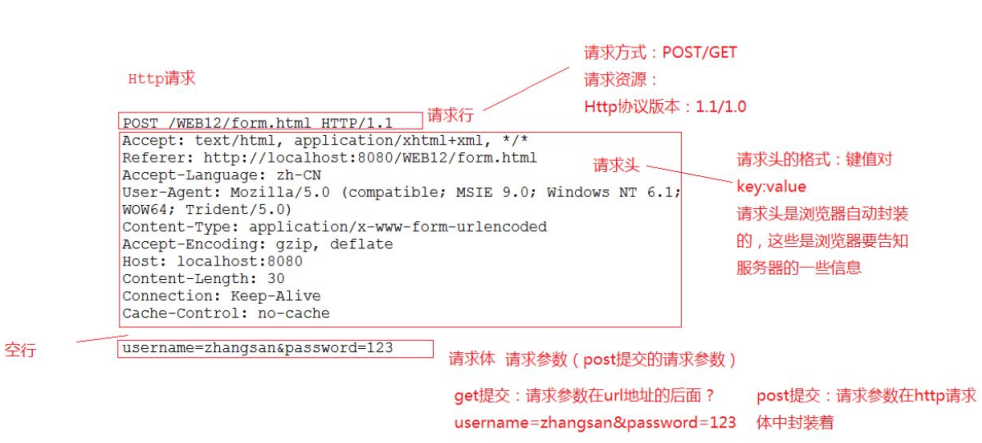
因为 request代表请求,所以我们可以通过该对象分别获得 Http请求的请求行,请求头和请求体
。
2 通过 request 获得请求行
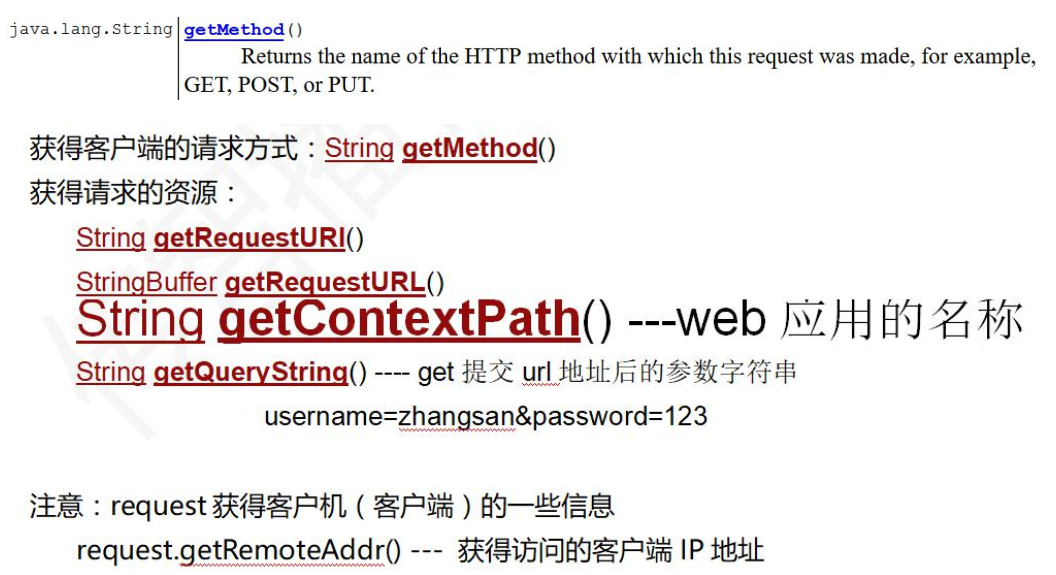
![]()

html部分代码:
<!DOCTYPE html> <html> <head> <meta charset="UTF-8"> <title>Insert title here</title> </head> <body> <form action="/WEBTest13/line" method="get"> <input type="text" name="username"><br> <input type="password" name="password"><br> <input type="submit" value="提交"><br> </form> </body> </html>
servlet代码:
package p5.request; import java.io.IOException; import javax.servlet.ServletException; import javax.servlet.http.HttpServlet; import javax.servlet.http.HttpServletRequest; import javax.servlet.http.HttpServletResponse; public class LineServlet extends HttpServlet { public void doGet(HttpServletRequest request, HttpServletResponse response) throws ServletException, IOException { //首先解决respone中文乱码 response.setContentType("text/html;charset=UTF-8"); // 1 获取客户端的请求方法 String method = request.getMethod(); System.out.println("method:"+method); // 2 获得请求的资源相关的内容 String requestURI = request.getRequestURI(); StringBuffer requestURL = request.getRequestURL(); System.out.println("requestURI:"+requestURI); System.out.println("requestURL:"+requestURL); // 3 获取web应用的名称 String contextPath = request.getContextPath(); System.out.println("contextPath:"+contextPath); // 4 获取地址后的参数字符串 String queryString = request.getQueryString(); System.out.println("queryString:"+queryString);
// 5 获得请求的协议版本
String protocol = request.getProtocol();
System.out.println("protocol:"+protocol); } public void doPost(HttpServletRequest request, HttpServletResponse response) throws ServletException, IOException { doGet(request, response); } }
运行结果:




3 Resquest 获得客户机的信息
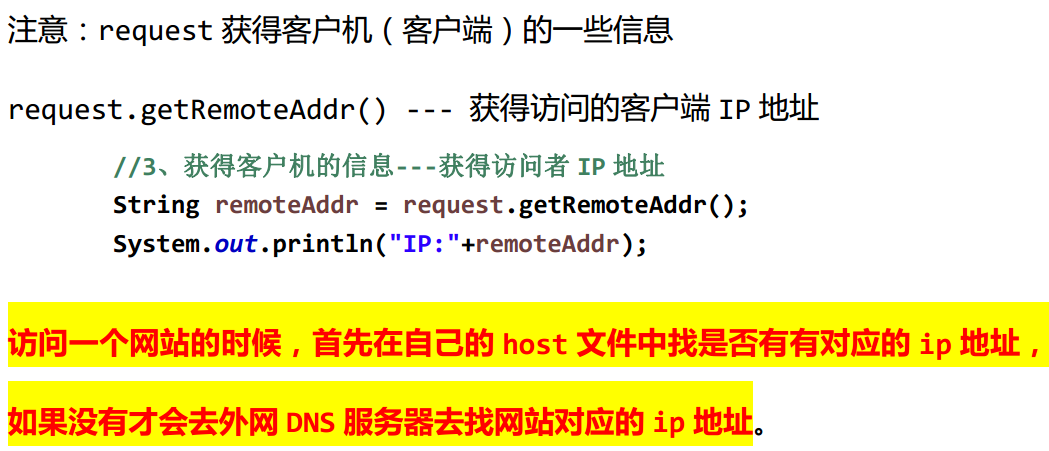
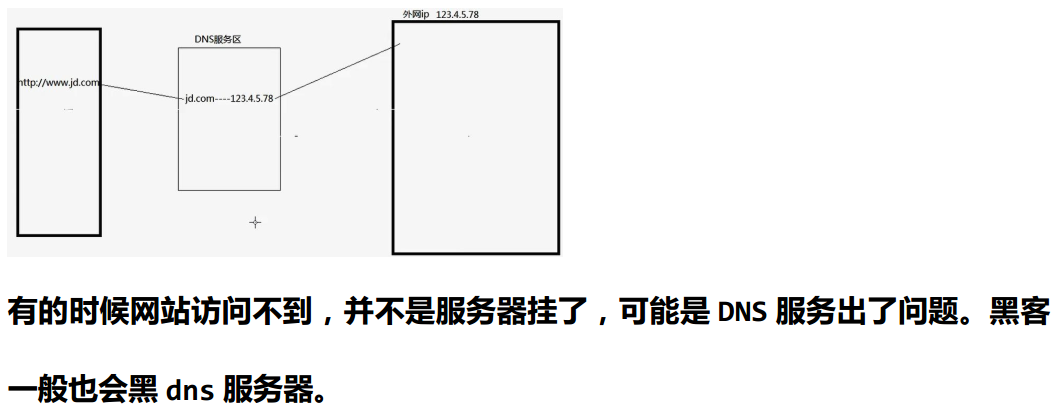



4 通过 request 获得【请求头】
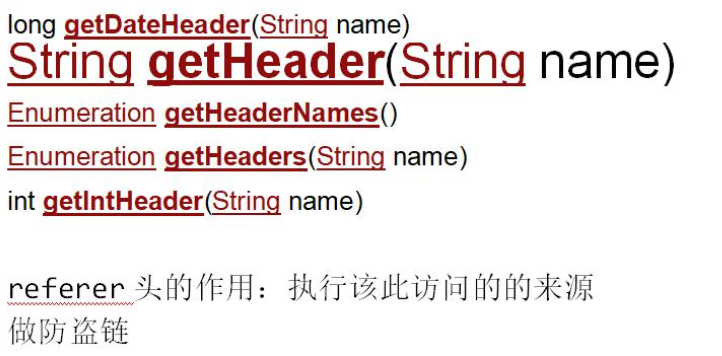
servlet代码:
package header; import java.io.IOException; import java.util.Enumeration; import javax.servlet.ServletException; import javax.servlet.http.HttpServlet; import javax.servlet.http.HttpServletRequest; import javax.servlet.http.HttpServletResponse; public class HeaderServlet extends HttpServlet { protected void doGet(HttpServletRequest request, HttpServletResponse response) throws ServletException, IOException { //1、获得指定的头 String header = request.getHeader("User-Agent"); System.out.println(header); //2、获得所有的头的名称 Enumeration<String> headerNames = request.getHeaderNames(); while(headerNames.hasMoreElements()){ String headerName = headerNames.nextElement(); String headerValue = request.getHeader(headerName); System.out.println(headerName+":"+headerValue); } } protected void doPost(HttpServletRequest request, HttpServletResponse response) throws ServletException, IOException { doGet(request, response); } }
html代码:
<!DOCTYPE html> <html> <head> <meta charset="UTF-8"> <title>Insert title here</title> </head> <body> <a href="/WEB15/referer">访问 headerServlet 资源</a> <form action="/WEBTest13/line" method="get"> <input type="text" name="username"><br> <input type="password" name="password"><br> <input type="submit" value="提交"><br> </form> </body> </html>

演示做防盗链代码实现
html部分代码:
<!DOCTYPE html> <html> <head> <meta charset="UTF-8"> <title>Insert title here</title> </head> <body> <a href="/WEB15/referer">奥运会金牌100块</a> </body> </html>
servlet代码
package header; import java.io.IOException; import javax.servlet.ServletException; import javax.servlet.http.HttpServlet; import javax.servlet.http.HttpServletRequest; import javax.servlet.http.HttpServletResponse; public class RefererServlet extends HttpServlet { protected void doGet(HttpServletRequest request, HttpServletResponse response) throws ServletException, IOException { //解决乱码问题 response.setContentType("text/html;charset=UTF-8"); //对该新闻的来源的进行判断 String header = request.getHeader("referer"); if(header!=null&&header.startsWith("http://localhost")){ //是从我自己的网站跳转过来的 可以看新闻 response.getWriter().write("中国确实已经拿到100块金牌...."); }else{ response.getWriter().write("你是盗链者,可耻!!"); } } protected void doPost(HttpServletRequest request, HttpServletResponse response) throws ServletException, IOException { doGet(request, response); } }
5 通过 request 获得【请求体】


html部分的代码:
<!DOCTYPE html> <html> <head> <meta charset="UTF-8"> <title>Insert title here</title> </head> <body> <a href="/WEBTest13/referer">访问headerServlet资源</a> <form action="/WEBTest13/line" method="get"> <input type="text" name="username"><br> <input type="password" name="password"><br> <input type="submit" value="提交"><br> </form> <hr/> <form action="/WEBTest13/content" method="get"> <input type="text" name="username"><br> <input type="password" name="password"><br> <input type="checkbox" name="hobby" value="zq">足球 <input type="checkbox" name="hobby" value="pq">排球 <input type="checkbox" name="hobby" value="ppq">乒乓球<br> <input type="submit" value="提交"><br> </form> </body> </html>
servlet部分代码:
package cotnet; import java.io.IOException; import java.util.Enumeration; import java.util.Map; import javax.servlet.ServletException; import javax.servlet.http.HttpServlet; import javax.servlet.http.HttpServletRequest; import javax.servlet.http.HttpServletResponse; public class ContentServlet extends HttpServlet { protected void doGet(HttpServletRequest request, HttpServletResponse response) throws ServletException, IOException { //1、获得单个表单值 String username = request.getParameter("username"); System.out.println(username); String password = request.getParameter("password"); System.out.println(password); //2、获得多个表单的值 String[] hobbys = request.getParameterValues("hobby"); for(String hobby:hobbys){ System.out.println(hobby); } //3、获得所有的请求参数的名称 Enumeration<String> parameterNames = request.getParameterNames(); while(parameterNames.hasMoreElements()){ System.out.println(parameterNames.nextElement()); } System.out.println("------------------"); //4、获得所有的参数 参数封装到一个Map<String,String[]> Map<String, String[]> parameterMap = request.getParameterMap(); for(Map.Entry<String, String[]> entry:parameterMap.entrySet()){ System.out.println(entry.getKey()); for(String str:entry.getValue()){ System.out.println(str); } System.out.println("---------------------------"); } } protected void doPost(HttpServletRequest request, HttpServletResponse response) throws ServletException, IOException { doGet(request, response); } }
6 Resquest 域对象和请求转发
1 request 是一个域对象

2 request 完成请求转发

servlet1代码:
package forward; import java.io.IOException; import javax.servlet.RequestDispatcher; import javax.servlet.ServletException; import javax.servlet.http.HttpServlet; import javax.servlet.http.HttpServletRequest; import javax.servlet.http.HttpServletResponse; public class Servlet1 extends HttpServlet { protected void doGet(HttpServletRequest request, HttpServletResponse response) throws ServletException, IOException { //想request域中存储数据 request.setAttribute("name", "tom"); //servlet1 将请求转发给servlet2 RequestDispatcher dispatcher = request.getRequestDispatcher("/servlet2"); //执行转发的方法 dispatcher.forward(request, response); } protected void doPost(HttpServletRequest request, HttpServletResponse response) throws ServletException, IOException { doGet(request, response); } }
servlet2代码:
package forward; import java.io.IOException; import javax.servlet.ServletException; import javax.servlet.http.HttpServlet; import javax.servlet.http.HttpServletRequest; import javax.servlet.http.HttpServletResponse; public class Servlet2 extends HttpServlet { protected void doGet(HttpServletRequest request, HttpServletResponse response) throws ServletException, IOException { //从request域中取出数据 Object attribute = request.getAttribute("name"); response.getWriter().write("hello haohao..."+attribute); } protected void doPost(HttpServletRequest request, HttpServletResponse response) throws ServletException, IOException { doGet(request, response); } }
运行结果:

3 ServletContext 域与 Request 域的生命周期比较?
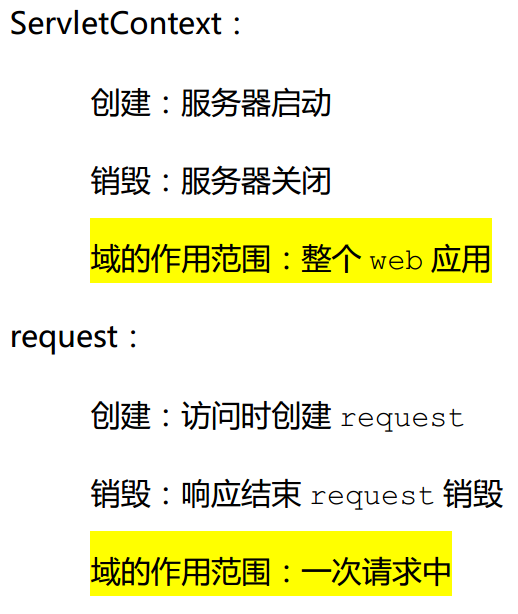
4转发与重定向的区别?


5 客户端地址与服务器端地址的写法?

7 注册分析
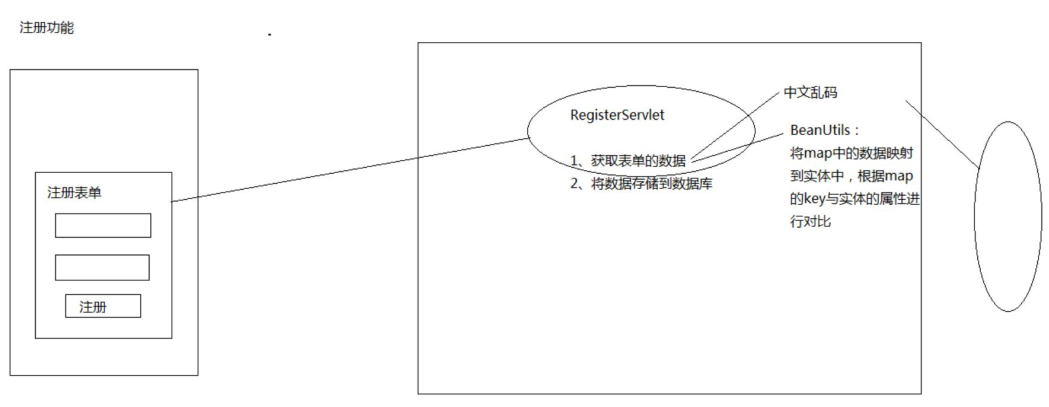
8 注册的基本实现
1 创建user表
CREATE TABLE `user` ( `uid` varchar(50) NOT NULL, `username` varchar(20) DEFAULT NULL, `password` varchar(20) DEFAULT NULL, `name` varchar(20) DEFAULT NULL, `email` varchar(30) DEFAULT NULL, `telephone` varchar(20) DEFAULT NULL, `birthday` varchar(20) DEFAULT NULL, `sex` varchar(10) DEFAULT NULL, `state` int(11) DEFAULT NULL, `code` varchar(64) DEFAULT NULL, PRIMARY KEY (`uid`) )
2 Servlet代码
package register; import java.io.IOException; import java.lang.reflect.InvocationTargetException; import java.sql.SQLException; import java.util.Map; import java.util.UUID; import javax.servlet.ServletException; import javax.servlet.http.HttpServlet; import javax.servlet.http.HttpServletRequest; import javax.servlet.http.HttpServletResponse; import org.apache.commons.beanutils.BeanUtils; import org.apache.commons.dbutils.QueryRunner; import com.ithiema.utils.DataSourceUtils; public class RegisterServlet extends HttpServlet { protected void doGet(HttpServletRequest request, HttpServletResponse response) throws ServletException, IOException { //设置request的编码---只适合post方式 request.setCharacterEncoding("UTF-8"); //get方式乱码解决 //String username = request.getParameter("username");//乱码 //先用iso8859-1编码 在使用utf-8解码 //username = new String(username.getBytes("iso8859-1"),"UTF-8"); //1、获取数据 //String username = request.getParameter("username"); //System.out.println(username); //String password = request.getParameter("password"); //..... //2、将散装的封装到javaBean //User user = new User(); //user.setUsername(username); //user.setPassword(password); //使用BeanUtils进行自动映射封装 //BeanUtils工作原理:将map中的数据 根据key与实体的属性的对应关系封装 //只要key的名字与实体的属性 的名字一样 就自动封装到实体中 Map<String, String[]> properties = request.getParameterMap(); User user = new User(); try { BeanUtils.populate(user, properties); } catch (IllegalAccessException | InvocationTargetException e) { e.printStackTrace(); } //现在这个位置 user对象已经封装好了 //手动封装uid----uuid---随机不重复的字符串32位--java代码生成后是36位 user.setUid(UUID.randomUUID().toString()); //3、将参数传递给一个业务操作方法 try { regist(user); } catch (SQLException e) { e.printStackTrace(); } //4、认为注册成功跳转到登录页面 response.sendRedirect(request.getContextPath()+"/login.jsp"); } //注册的方法 public void regist(User user) throws SQLException{ //操作数据库 QueryRunner runner = new QueryRunner(DataSourceUtils.getDataSource()); String sql = "insert into user values(?,?,?,?,?,?,?,?,?,?)"; runner.update(sql,user.getUid(),user.getUsername(),user.getPassword(),user.getName(), user.getEmail(),null,user.getBirthday(),user.getSex(),null,null); } protected void doPost(HttpServletRequest request, HttpServletResponse response) throws ServletException, IOException { doGet(request, response); } }
2 User类

package register; public class User { private String uid; private String username; private String password; private String name; private String email; private String sex; private String birthday; public String getUid() { return uid; } public void setUid(String uid) { this.uid = uid; } public String getUsername() { return username; } public void setUsername(String username) { this.username = username; } public String getPassword() { return password; } public void setPassword(String password) { this.password = password; } public String getName() { return name; } public void setName(String name) { this.name = name; } public String getEmail() { return email; } public void setEmail(String email) { this.email = email; } public String getSex() { return sex; } public void setSex(String sex) { this.sex = sex; } public String getBirthday() { return birthday; } public void setBirthday(String birthday) { this.birthday = birthday; } @Override public String toString() { return "User [uid=" + uid + ", username=" + username + ", password=" + password + ", name=" + name + ", email=" + email + ", sex=" + sex + ", birthday=" + birthday + "]"; } }
9 注册的乱码解决


10 用户登录失败的信息回显
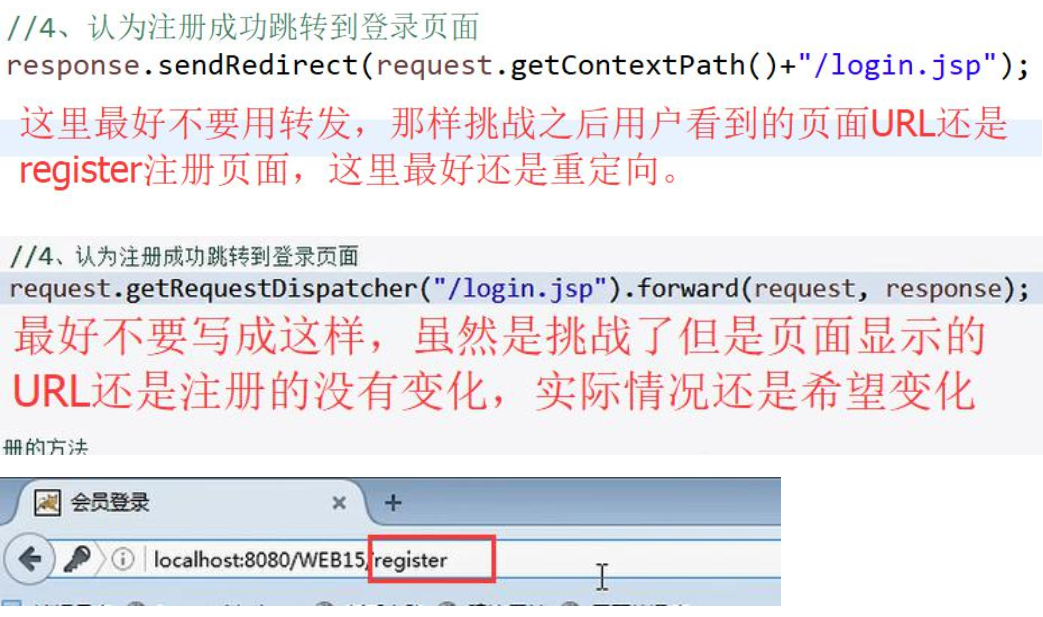
![]()
1 LoginServlet 代码 :
package login; import java.io.IOException; import java.sql.SQLException; import javax.servlet.ServletException; import javax.servlet.http.HttpServlet; import javax.servlet.http.HttpServletRequest; import javax.servlet.http.HttpServletResponse; import org.apache.commons.dbutils.QueryRunner; import org.apache.commons.dbutils.handlers.BeanHandler; import com.ithiema.register.User; import com.ithiema.utils.DataSourceUtils; public class LoginServlet extends HttpServlet { protected void doGet(HttpServletRequest request, HttpServletResponse response) throws ServletException, IOException { request.setCharacterEncoding("UTF-8"); //1、获得用户名和密码 String username = request.getParameter("username"); String password = request.getParameter("password"); //2、调用一个业务方法进行该用户查询 User login = null; try { login = login(username,password); } catch (SQLException e) { e.printStackTrace(); } //3、通过user是否为null判断用户名和密码是否正确 if(login!=null){ //用户名和密码正确 //登录成功 跳转到网站的首页 response.sendRedirect(request.getContextPath()); }else{ //用户名或密码错误 //跳回当前login.jsp //使用转发 转发到login.jsp 向request域中存储错误信息 request.setAttribute("loginInfo", "用户名或密码错误"); request.getRequestDispatcher("/login.jsp").forward(request, response); } } public User login(String username,String password) throws SQLException{ QueryRunner runner = new QueryRunner(DataSourceUtils.getDataSource()); String sql = "select * from user where username=? and password=?"; User user = runner.query(sql, new BeanHandler<User>(User.class), username,password); return user; } protected void doPost(HttpServletRequest request, HttpServletResponse response) throws ServletException, IOException { doGet(request, response); } }
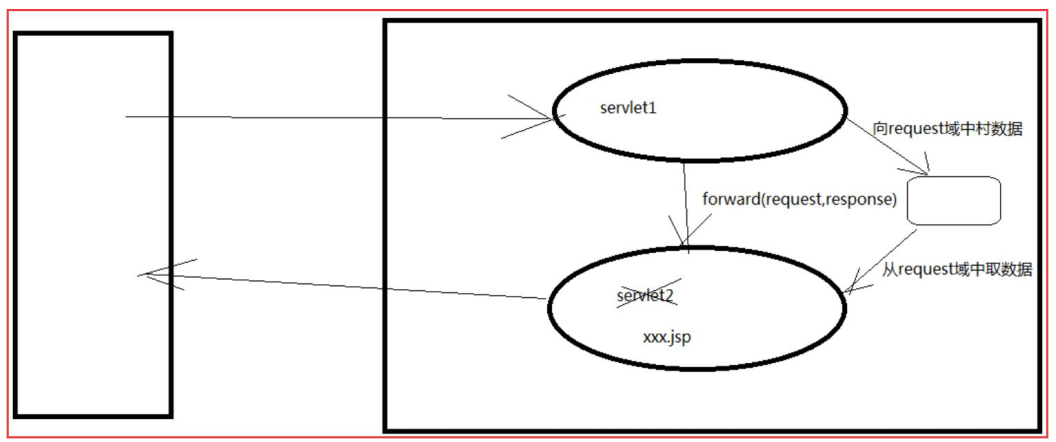
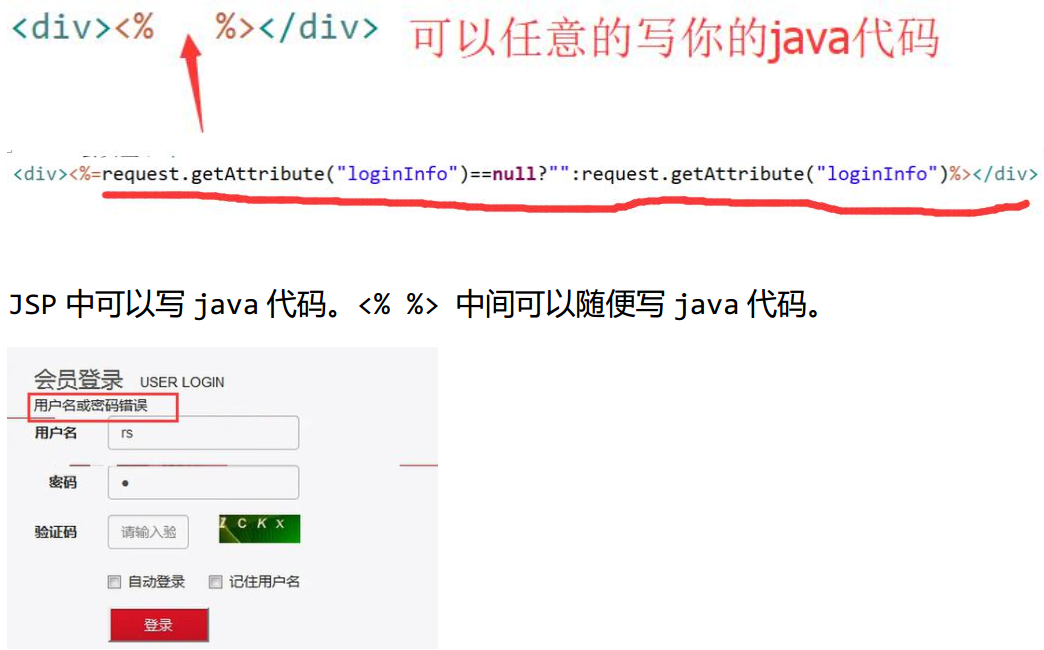
2 login.jsp代码
<%@ page language="java" contentType="text/html; charset=UTF-8" pageEncoding="UTF-8"%> <!DOCTYPE html> <html> <head> <meta name="viewport" content="width=device-width, initial-scale=1"> <title>会员登录</title> <link rel="stylesheet" href="css/bootstrap.min.css" type="text/css" /> <script src="js/jquery-1.11.3.min.js" type="text/javascript"></script> <script src="js/bootstrap.min.js" type="text/javascript"></script> <!-- 引入自定义css文件 style.css --> <link rel="stylesheet" href="css/style.css" type="text/css" /> <style> body { margin-top: 20px; margin: 0 auto; } .carousel-inner .item img { width: 100%; height: 300px; } .container .row div { /* position:relative; float:left; */ } font { color: #666; font-size: 22px; font-weight: normal; padding-right: 17px; } </style> </head> <body> <!-- 引入header.jsp --> <jsp:include page="/header.jsp"></jsp:include> <div class="container" style=" 100%; height: 460px; background: #FF2C4C url('images/loginbg.jpg') no-repeat;"> <div class="row"> <div class="col-md-7"> <!--<img src="./image/login.jpg" width="500" height="330" alt="会员登录" title="会员登录">--> </div> <div class="col-md-5"> <div style=" 440px; border: 1px solid #E7E7E7; padding: 20px 0 20px 30px; border-radius: 5px; margin-top: 60px; background: #fff;"> <font>会员登录</font>USER LOGIN <div><%=request.getAttribute("loginInfo")==null?"":request.getAttribute("loginInfo")%></div> <form class="form-horizontal" action="/WEB15/login" method="post"> <div class="form-group"> <label for="username" class="col-sm-2 control-label">用户名</label> <div class="col-sm-6"> <input type="text" class="form-control" id="username" name="username" placeholder="请输入用户名"> </div> </div> <div class="form-group"> <label for="inputPassword3" class="col-sm-2 control-label">密码</label> <div class="col-sm-6"> <input type="password" class="form-control" id="inputPassword3" name="password" placeholder="请输入密码"> </div> </div> <div class="form-group"> <label for="inputPassword3" class="col-sm-2 control-label">验证码</label> <div class="col-sm-3"> <input type="text" class="form-control" id="inputPassword3" placeholder="请输入验证码"> </div> <div class="col-sm-3"> <img src="./image/captcha.jhtml" /> </div> </div> <div class="form-group"> <div class="col-sm-offset-2 col-sm-10"> <div class="checkbox"> <label> <input type="checkbox"> 自动登录 </label> <label> <input type="checkbox"> 记住用户名 </label> </div> </div> </div> <div class="form-group"> <div class="col-sm-offset-2 col-sm-10"> <input type="submit" width="100" value="登录" name="submit" style="background: url('./images/login.gif') no-repeat scroll 0 0 rgba(0, 0, 0, 0); height: 35px; 100px; color: white;"> </div> </div> </form> </div> </div> </div> </div> <!-- 引入footer.jsp --> <jsp:include page="/footer.jsp"></jsp:include> </body> </html>
11 知识点总结
